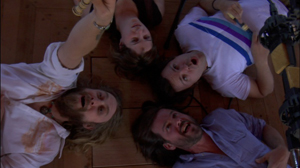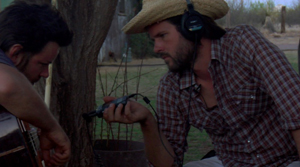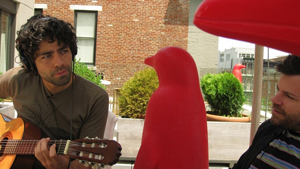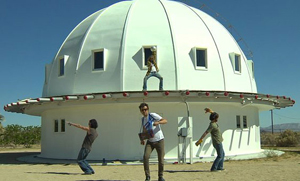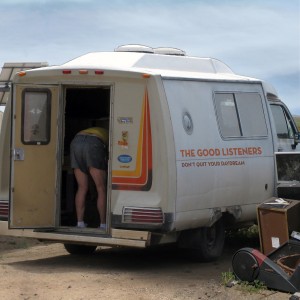The Good Listeners Bring “Don’t Quit Your Daydream” To Woodstock
WOODSTOCK, NY: Couple weeks back, we had the opportunity to attend one of Levon Helm’s Midnight Rambles up at his studio, “The Barn,” in the woods of Woodstock, NY. It was the weekend of the Woodstock Film Festival, and Don’t Quit Your Daydream, a documentary about LA-based duo The Good Listeners, was a featured film making its East Coast premiere.
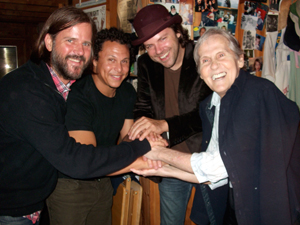
At The Midnight Ramble (l-r): The Good Listeners' Clark Stiles, Josh Crawley, Nathan Khyber and Levon Helm
Helm, legendary drummer for The Band, invited The Good Listeners to open the Ramble on Saturday night and they fit right in, bringing the rowdy, music-loving audience to their feet with tunes from the Don’t Quit Your Daydream album.
The story of The Good Listeners and the making of their latest record is an odyssey wherein band-mates Nathan Khyber and Clark Stiles pack up all their instruments and studio equipment, jump in an RV, and head out on a month-long, cross-country trip stopping to record a song-a-day in 10 different locations.
The Good Listeners make a kind of alt-pop music that fuses acoustic and electric indie roots-rock sounds with experimental studio sonics. Both are multi-instrumentalists, but Khyber is the singer/songwriter and Stiles is the producer who builds their sonic world, a pastiche of live playing and looped guitars, sampled sounds, pedal FX and analog synths. If David Byrne and Brian Eno hopped in an RV with some choice equipment, and gave themselves similar restrictions, the result might not be so far off from Don’t Quit Your Daydream.
The key to The Good Listeners’ sound is spontaneity, and they’ve been inventive about how to enforce that in their recordings. Their first record, Ojai, was made from scratch in ten days in a home studio in Ojai, CA; their second, Crane Point Lodge, was written and recorded over a month in a lodge in the Adirondacks; and their third album, Don’t Quit Your Daydream, was recorded on the road in ten non-studio locations around the country with a collaborator in each port. This is the process documented in the film.
“We approach each record as a blank canvas,” says Khyber. As for Don’t Quit Your Daydream, in particular, he shares, “We really didn’t have a game plan starting out. We write the songs in a stream-of-consciousness kind of way — very quickly and on a daily basis. But one thing we did plan in taking it out on the road was to get some local flavors and indigenous styles on the recording.”
Stops along the Don’t Quit Your Daydream trail included “The Integratron” dome out in the Mojave desert where they teamed up with musician/songwriter Bingo Richey, a Bayou Swamp Tour boat in Louisiana where they hooked up with Cajun musical tour-guide Ron Black Guidry, and a horse barn in Louisville where they met up with friend and actor/musician Adrian Grenier.
On the East Coast, they tracked songs at the Paul Green School of Rock in Philly with teenage rocker Gina Gleason and on a Brooklyn rooftop with college athlete and musician Christian Strekely. In each location, they wrote and recorded a song in one day with their collaborators, totally from scratch.
Lyrically, the album channels a kind of peripatetic spirit, and a longing for connection that’s literally being played out in the production process as the guys find a way to connect creatively to people whom (in most cases) they’ve never met. Even with the diverse locations and flavors, there’s a real cohesiveness to the sound of the record overall; it’s both real and cinematic in how it documents what happened in that location, on that day, the songs building like stanzas in a modern-day epic poem.
“A lot of that is Clark’s doing,” says Khyber of the album’s cohesive sound. “He’s a really good producer. And our process is organic in that a lot of what we do is based around the hiccups that we stumble across, and artifacts that are left over in the looping process.”
Tracking A Record Cross-Country
Stiles had been working as a producer in Los Angeles, engineering records for The Dandy Warhols and Pink Martini among others, when he and Khyber formed The Good Listeners. He’d been burning out on producing with other bands, and decided it was time to retire from the studio grind.
“I found myself working on other records thinking about how great it would be to be putting as much effort into my own records,” says Stiles. “So I found new ways to make money and let my work be my work and let music be fun. Nathan and I have a really strong skill-set and it’s so nice to be doing it for ourselves.” As a result, this band has the benefit of a fine-tuned production process, conceptualized by a skilled recording engineer.
“We subscribe to the point of view, based on our experience, that the things that you don’t deliberate on, the unintended things, are the best,” says Stiles. “We like to let things happen, and unfold and the accidents are greatly welcome because the most exciting thing about music is when it’s unpredictable and you can’t think your way into unpredictable, it just has to happen.”
To make Don’t Quit Your Daydream, the guys and their roadie musician buddies unpacked and setup a full-fledged studio in each location. “We arrange all of our gear in such a way that we can just bounce around to the different stations and not have to think too much about making special patches for anything we might want to do,” says Khyber.
And it’s an impressive assemblage of musical equipment they carted around. “We have a mishmash of gear we’ve been collecting since the 80s,” Stiles notes. “I have some old Neumann microphones, an awesome drum set from the 80s, we’ve got a Rhodes and a Wurlitzer, but then we’re also using Pro Tools and we have a new Moog. We hang onto gear we love and buy a few new things every time we make a record.
“For pre-amps, I have some APIs, GMLs and Manleys. I don’t use any outboard compression — we basically record everything flat, I go straight from the mic pre to the Apogee converter into Pro Tools and the majority of what we do in Pro Tools is really just hi-pass filtering, very little EQ’ing. I try to keep everything as natural sounding as possible. It’s nice because then we like to mix in miscellaneous sounds and we have a lot more fun trying to get the sound in the room as opposed to over-tweaking in Pro Tools.”
The production of a song is about capturing the new environments, nuances, musical and lyrical gems of each day. “We want the outside noises to leak into the music a bit, so that we feel like we’re wrangling the sound more than creating it in a lot of cases.”
In this way the method of production becomes an intrinsic aspect of the band’s identity, their sound. “It really works for us,” Khyber allows.
“It’s really refreshing for both Clark as a producer and musician and for me as a writer to kind of do this so quickly that we’re not second-guessing ourselves to a degree and belaboring something when your gut instinct is typically the right move anyway.
So a lot of the record is first passes, first vocal takes. I think the process has enabled us to keep it fresh and fresh sounding.”
And Stiles mixes as they go. “It shouldn’t take that long to write, record and mix a song and that’s kind of our theory,” says Stiles. “If you listen to our end of day mix as opposed to the album versions, they’re not that far off. I typically mix while I record and we’re editing while we’re writing; we’re doing all the work that day.”
The Journey Is The Destination
At the end of the month-long trip from Los Angeles to NYC, The Good Listeners had an album, amazing footage for their documentary and a great, human story to tell. “I think what we learned through making this record is that we actually have something to share,” says Stiles.
“We’ve spent years developing our skills and craftsmanship and that is something that’s really nice to go out and share with other musicians. We learned a lot from our collaborators and we tried to give something back to them as well.”
As for the fans, well, the DVD + CD experience of Don’t Quit Your Daydream is super-engaging. Watch the movie, listen to the finished record, and you feel you’ve traveled the road with them and you’re that much more connected to their songs. Or at a film-screening event, hear them live and it completes the journey.
“I think it’s quite nice to see the genesis of the songs and then see them come to fruition on stage,” says Khyber…as in The Midnight Ramble, a perfect epilogue for those who caught the film. And it was a high point for the band.
“It was very intimidating, we were actually kind of terrified,” says Khyber. “We’re certainly no hacks, but we also don’t feel we’re virtuoso instrumentalists. And there we were playing in a room with guys like the musical director for Bob Dylan’s band!
“But it went over quite well and people did really seem to enjoy it. And you always have to remind yourself that, at the end of the day, you’ve written these songs and if you’re able to perform them and people are into it then you’ve done your job!”
For more on The Good Listeners and Don’t Quit Your Daydream, visit http://www.thegoodlisteners.com and http://www.dontquityourdaydream.com. Download the movie and album on iTunes!
Please note: When you buy products through links on this page, we may earn an affiliate commission.







